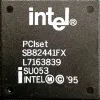
Socket 8 was a CPU socket introduced by Intel in 1995. It was specifically designed for the Intel Pentium Pro processors, which were the high-end CPUs of that time.
Socket 8 featured a staggered pin grid array (SPGA) design with 387 pins, which allowed for a reliable connection between the processor and the motherboard. It supported a front-side bus (FSB) speed of up to 66 MHz and offered compatibility with both 3.3V and 5V voltage levels.
The Socket 8 architecture provided a significant improvement over its predecessor, Socket 7, in terms of performance and capabilities. It introduced a dual-independent bus design, which separated the data and instruction buses, enhancing system efficiency and overall performance.
However, Socket 8 had a relatively short lifespan. It was quickly replaced by the Slot 1 and Slot 2 architectures, which featured a cartridge-style design for improved scalability and easier CPU installation. These new form factors offered better performance and compatibility with newer processor generations.
Despite its limited existence, Socket 8 contributed to the evolution of CPU socket designs and laid the foundation for future advancements in Intel's processor architectures.
